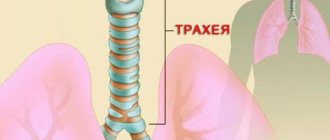Colds are perhaps the most common diseases occurring in patients of different ages and genders. Adults, faced with such a problem, rarely go to the doctor, preferring to be treated on their own. But sometimes a common cold occurs in an atypical manner and causes some particularly unpleasant symptoms. If uncharacteristic changes in your health occur, it would be a good idea to consult a doctor. A fairly common complaint with various acute respiratory infections and acute respiratory viral infections is a cough with difficult to clear sputum, the treatment of which in adults we will consider in a little more detail.
Coughing with difficult to clear sputum is a rather dangerous symptom. Indeed, if there is insufficient sputum discharge, it begins to stagnate and forms clots. Such clots can lead to the development of serious inflammatory processes. That is why poor mucus discharge when coughing requires close attention and adequate therapy.
How to correct a cough with difficult to clear sputum, what treatment to use?
Patients experiencing a cough that is accompanied by difficult sputum separation should be in clean, well-ventilated rooms with a sufficient level of humidity (50-55%). Dirt, dust and dry air negatively affect the condition of the bronchi as a whole and cause the synthesis of particularly sticky and viscous sputum. Smoking and respiratory infections have the same effect.
In addition to excluding aggressive factors, patients with a cough that is accompanied by difficult-to-clear sputum must maintain sufficient drinking regimen. Drinking plenty of fluids (at least one and a half liters of fluid per day) helps thin mucus and promotes its evacuation from the bronchi.
Inhalations for coughs with difficult to separate sputum
In the absence of specific contraindications, inhalations are indicated for patients with this problem. Regular water vapor, inhalation with the addition of saline or soda solution, as well as a variety of plant extracts will help to cope with a cough with difficult to separate sputum. Inhalations perfectly moisturize mucous surfaces, eliminate pain, and reduce the severity of reflex stimulation inside the cough center in the brain. In addition, such procedures are good at thinning mucus and relaxing the muscles in the bronchi.
An excellent effect when coughing with difficult to separate sputum is obtained by inhalation with ordinary potatoes. It needs to be boiled in its skins and the water drained. Breathe over the resulting steam for ten minutes. Carry out this procedure twice a day and be especially careful not to get burned.
Expectorants for coughs with hard-to-clear sputum
Expectorant medications can reduce the viscosity of mucus, increasing its quantity. Thanks to this property, the secretion leaves the respiratory tract more easily during coughing. Patients with this disorder are often recommended to use reflex medications; they are represented by licorice, thermopsis and essential oils. Such drugs stimulate irritation of receptors, activating the secretion of glands in the bronchi.
So, for this disorder, licorice root syrup can be used; it has not only an expectorant, but also an antispasmodic effect. This preparation should be drunk with a dessert spoon, dissolving this amount of syrup in half a glass of water. Repeat the intake three times a day. The duration of such treatment can range from one week to ten days.
Also, when coughing with sputum that is difficult to separate, resorptive medications can be used. These products are represented by ammonium chloride, soda and potassium iodide. The active substances are absorbed by the digestive tract, helping to thin the mucus and simplify its evacuation.
So potassium iodide can be purchased in the form of a 1-3% solution. It should be taken a couple of tablespoons three to four times a day.
Such medications help thin mucus and remove it from the bronchi. When coughing with sputum that is difficult to separate, you can use drugs that affect the viscosity of bronchial secretions and its elasticity. The most famous representative of such drugs is ACC.
To speed up the evacuation of mucus from the bronchi, Ambroxol or Bromhexine can be used. To reduce the volume of mucus produced, M-anticholinergics, Libexin Muco, and glucocorticoids are used.
Patients suffering from a cough with difficult to clear sputum are strongly advised to give up bad habits and adhere to a properly balanced diet. They should pay attention to physical exercise, because constantly being in a static position aggravates congestion by an order of magnitude. Walking in the fresh air and doing exercises (the simplest exercises) will be beneficial, but only in the absence of fever.
To treat cough with difficult-to-discharge sputum, various traditional medicines can be used. The use of pine buds gives an excellent effect. Brew a tablespoon of this raw material with one glass of just boiled water. Infuse the medicine under the lid for twenty minutes, then strain. Take the prepared infusion half a glass twice a day during meals. The duration of such treatment can reach one month.
Published in the magazine: “Local Therapist”, 2011, No. 5, p. 23
Cough, especially chronic cough, significantly reduces the quality of life of patients, disrupting sleep, physical and intellectual activity. A severe cough can lead to the development of a number of complications (hemoptysis, vomiting, urinary incontinence), the most serious of which is spontaneous pneumothorax. It should be borne in mind that a prolonged increase in intra-abdominal pressure contributes to the formation of hernias of the anterior abdominal wall.
With a productive cough, the main task is to ensure effective drainage of the bronchi, facilitating maximum removal of sputum.
In some cases, a productive cough may be ineffective; the reasons for this may be:
- insufficiently expressed cough reflex;
- sputum viscosity is too high;
- low power of the air stream during a cough impulse;
- insufficiently deep breathing (promotion of secretion in the bronchi is proportional to the depth of breathing).
Therapeutic options
Drugs that stimulate expectoration (secretomotor) enhance the physiological activity of the ciliated epithelium and the peristaltic movements of the bronchioles, promoting the movement of sputum through the respiratory tract and its subsequent elimination. The achieved effect is usually accompanied by increased secretion of the bronchial glands and a slight decrease in sputum viscosity.
Means of reflex action (preparations of thermopsis, istoda, marshmallow, terpinhydrate, etc.) A number of drugs of reflex action partially have a resorptive effect: the essential oils and other substances they contain are released through the respiratory tract and cause increased secretion and dilution of sputum. Resorptive agents (sodium and potassium iodide, ammonium chloride, partially sodium bicarbonate, etc.), absorbed in the gastrointestinal tract, are secreted by the mucous membrane of the respiratory tract, stimulating the bronchial glands and causing direct dilution of sputum.
Mucolytic (secretolytic) agents have the ability to thin sputum as a result of the breakdown of complex mucins, and thereby reduce its viscosity and facilitate evacuation.
- Proteolytic enzymes.
- Amino acids with SH group.
- Mucoregulators (bromhexine, ambroxol hydrochloride)
Mucoregulators:
- have mucolytic and expectorant effects.
- stimulate the regeneration of ciliated cells of the ciliated epithelium, increase its activity.
- stimulate the synthesis of surfactant and block its breakdown.
In order to relieve cough and accelerate the cleansing of the respiratory tract, the domestic drug Codelac ® Broncho was developed; its effects are due to the pharmacological properties of its components. Ambroxol hydrochloride (active metabolite of bromhexine) - stimulates the formation of tracheobronchial secretion of low viscosity by changing the chemistry of sputum mucopolysaccharides, improves mucociliary transport by stimulating the motor activity of the cilia of the ciliated epithelium. Ambroxol's ability to increase the synthesis and secretion of surfactant and block its breakdown is significantly higher than that of bromhexine. Having a positive effect on surfactant production, ambroxol indirectly increases mucociliary transport (reducing the adhesion of bronchial mucus), which, in combination with increased secretion of glycoproteins (mucokinetic effect), causes a pronounced expectorant effect. Taking the drug has a significant effect on the viscosity of sputum, its purulence and airway patency.
The peculiarity of ambroxol is its lack of ability to provoke bronchospasm.
Sodium glycyrrhizinate has anti-inflammatory, antiallergic and antiviral effects. Due to the presence of antioxidant and membrane-stabilizing activity, it has a cytoprotective effect.
Thermopsis extract has an expectorant effect and reflexively increases the secretion of the bronchial glands.
Sodium bicarbonate reduces the viscosity of sputum and stimulates the motor function of the ciliated epithelium and bronchioles.
Thus, the drug Codelac ® Broncho, due to the pharmacological properties of its constituent components, is capable of simultaneously influencing several parts of the pathological process, which is very valuable in clinical practice.
Treatment of cough should begin with eliminating its cause. General recommendations: sufficient fluid intake, humidified air in the room.
Important! It is necessary to assess the nature of the cough, and in case of a productive cough, the nature of the bronchial secretion, identifying the presence or absence of bronchospasm. Treatment of cough is not limited to suppressing it!
Indications for use: diseases of the respiratory tract with difficulty in sputum discharge:
- acute and chronic bronchitis;
- pneumonia;
- COPD;
- bronchiectasis.
Dosage regimen
- Adults and children over 12 years of age: orally during meals, 1 tablet 3 times a day.
- It is not recommended to use the drug for more than 4-5 days without a doctor's prescription.
Based on materials from the magazine “Consilium medicum”
Most people treat colds on their own, without the help of a doctor. A symptom that accompanies respiratory diseases is cough. It can be productive or unproductive. But sometimes the cough becomes atypical, that is, one in which it is very difficult to clear sputum. Sputum in the bronchi not only slows down the healing process, but also bothers the patient with severe coughing attacks. In this case, you need to visit a doctor and undergo all the necessary tests.
The child cannot cough up sputum - reasons
In healthy people, sputum is produced in small quantities. It helps cleanse the body of dust and germs that enter the respiratory system. But during illness, sputum changes its properties. Cough with hard-to-clear sputum in adults can have different causes. The sputum itself that comes out is also different. What it could be:
- purulent;
- white or yellow;
- sputum interspersed with blood.
To facilitate diagnosis, it is recommended to have sputum tested.
What diseases are indicated by a dry cough with difficult to clear sputum:
- pathological inflammatory processes in the respiratory organs;
- asthma;
- bronchitis;
- croup
This symptom also often bothers smokers and people working in the chemical or cosmetics industry.
Heavy expectoration of mucus when coughing is a symptom of the following diseases:
- asthma;
- pneumonia,
- tuberculosis;
- bronchitis;
- whooping cough;
- exacerbation after a respiratory infection.
This symptom may bother people living in areas with very polluted air.
The color of the sputum will help determine the cause of the disease.
Treating a cough on your own without finding out the cause is very dangerous. If treatment is started quickly in adults or children, the sputum will begin to disappear and the patient will begin to recover.
Features of sputum
When coughing with sputum that is difficult to clear, it is also important to pay attention to the nature of the discharge. In an adult or child, it may have a different color. This or that shade may indicate a certain disorder.
The production of yellow sputum when coughing may indicate the presence of:
- sinusitis;
- bronchitis;
- pneumonia.
People with sinusitis usually have yellow sputum.
If a severe paroxysmal cough with yellowish sputum spontaneously occurs, you should urgently contact your doctor and inform him of all the signs present. In this case, the cough may be dry. Relieving the condition will not be easy. You may need urgent help from specialists.
The greatest danger may be yellowish discharge, which contains an admixture of blood or pus. In this case, the patient usually experiences an unpleasant metallic taste in the mouth. To diagnose the disease, you will need to submit the discharged material for research. Collection of secretions should be carried out on an empty stomach in the morning. Experts pay attention to the viscosity of the mucus, its color, etc.
It is worth noting that viscous, difficult to separate sputum, which has a yellowish tint, can be caused by constant smoking. This is usually a sign of obstructive bronchitis.
Yellow sputum may be produced if there is inflammation in the lungs
In children and adults, coughing with poorly separated sputum is common. The discharge may be white. This kind of phlegm cannot be ignored. It can signal the presence of tuberculosis and fungal infections.
Fungal infections occur most often when a person has been treated with antibacterial drugs and his immune system is severely suppressed. With tuberculosis, the patient coughs constantly. The presence of a dry and frequent cough brings great discomfort to the patient. With this disease, sputum is difficult to separate. It is released in small quantities.
The discharge may contain blood and pus. Typically, such inclusions signal damage to the respiratory system. If they are present, you need to urgently resort to treatment. Blood present in the form of veins indicates malignant tumors in the lungs. However, such a symptom may also be present with bronchitis. It is almost impossible to independently determine the cause of the disease.
Fungal infections may be accompanied by a cough with sputum that is difficult to clear.
What treatment can the doctor prescribe?
The emphasis in treating cough in a child or adult is to eliminate its root cause. Medicines are prescribed only by the attending physician after a complete examination and diagnosis. Preferably drugs are prescribed that help remove sputum. Among them:
Most of these medications contain sodium salt, which helps soften the mucus and make it less sticky. But these drugs are not recommended to be taken;
- with high blood pressure;
- people with adrenal diseases;
- patients with ulcers;
- when there is blood in the sputum.
Treatment of cough with difficult to clear sputum in a child is treated with syrups, for example, from licorice root.
If the patient coughs paroxysmally, the doctor may prescribe:
In severe cases, treatment is carried out with antibiotics. The course of therapy is prescribed only by a doctor. Drugs to treat symptoms are prescribed individually.
Types of mucus produced when coughing
Only an experienced specialist can answer how to remove phlegm from a child or an adult. Therapists and pediatricians are required to pay attention to the type of mucus that is released during attacks. Only after this is cough medicine prescribed.
Studying mucus is an important stage of diagnosis. This is the only way to cure a constant cough with phlegm. Sometimes it is necessary to undergo certain tests to rule out serious pathologies. Difficult sputum can be of various types:
- Yellow sputum when coughing is a symptom of sinusitis, bronchitis or pneumonia. Bronchospasm occurs suddenly and causes discomfort. If a person abuses nicotine, a cough with yellow sputum may also appear, especially in the morning after waking up. A special procedure performed on an empty stomach helps diagnose the disease. Coughing in the morning also indicates purulent processes in the lungs or bronchi.
- White mucus occurs during tuberculosis or during a fungal infection. Fungus can occur due to prolonged therapy with antibacterial drugs. White frothy sputum appears in small quantities during tuberculosis.
- A cough with white sputum and bloody streaks is a diagnosis of a complication that has led to damage to the vessels of the larynx. Viruses cause the disease.
- Clear sputum when coughing is a symptom of a typical cold. Therapy is prescribed by a doctor and lasts no more than 7-10 days. Most often these are tablets or syrup for phlegm.
- Thick mucus when an adult coughs with blood is an alarming symptom indicating cancer or severe pneumonia.
What to do if the mucus does not come out during a cough? This question interests many. A cough with sputum production that lasts more than 7-10 days requires examination by a physician.
Review of drugs
To treat a cough with sputum that is difficult to clear, medications are prescribed that include the following substances:
- Carbocysteine;
- Ambroxol (or bromhexine);
- Acetylcysteine.
Carbocisteine activates contractions of the respiratory muscles, improves the functioning of the mucous membrane of the respiratory tract and softens phlegm. Preparations that contain the substance:
- pregnancy;
- kidney, gastrointestinal and bladder diseases.
Sodium salt (or Acetylcysteine) softens sputum, but at the same time increases its volume. Has an anti-inflammatory effect. Preparations that contain it:
- hypertension;
- stomach ulcer;
- diseases of the kidneys and their appendages;
- discharge with blood.
Ambroxol or bromhexine have almost the same effect. They dilute mucus and improve its removal from the respiratory tract. Preparations:
These medications should not be taken by pregnant women or people with stomach ulcers.
In addition to the above-mentioned medications, there are lozenges, for example, Mucaltin. Althea root syrups and Pertussin syrup are also quite effective. They are recommended for use by children.
Inhalations can be used as an adjuvant therapy. It is advisable to do this method using a nebulizer - a special device. But they also use improvised means, for example, a saucepan or a kettle. For inhalation use:
- medicinal herbs;
- essential oils;
- saline solution;
- medicines;
- mineral water.
Doctors also recommend “natural inhalation” - a hike in the forest or a trip to the sea. This remedy will help soften phlegm and remove it from the body. But, like any method of treatment, inhalations have a number of contraindications. They cannot be done:
- babies;
- at elevated temperatures;
- with nosebleeds;
- people with cardiovascular disease;
- for problems with the respiratory system.
Treatment with inhalations alone will not give a good result. This should be carried out in combination with the main therapy.
Symptoms of cough with phlegm
As the symptoms of the disease progress with the accumulation of secretions from the bronchial tree, the need arises to cleanse the respiratory tract of accumulated secretions. In this case, the cough reflex is triggered - the urge to sharply exhale air, due to irritation of the walls of the bronchi with mucous secretion.
When an abundance of mucus appears, it is important to distinguish the cleansing process from the transition of inflammatory pathology to a chronic form.
Typically, the coughing movement begins with a sharp and deep breath, which lasts no more than 2 seconds. After this, the laryngeal muscles covering the glottis also sharply contract. The bronchial muscles immediately come to tone, the abdominal muscles contract - this action of the muscle fibers is aimed at overcoming the resistance of the closed glottis. At this moment, the pressure inside the chest cavity is about 100 mmHg. Art. Next, there is a sudden opening of the glottis and increased exhalation. Basically, if the bronchi have accumulated secretions, the cough reflex is triggered involuntarily, but the patient himself is able to trigger it independently.
As a rule, a cough attack and bronchial mucous discharge in itself are not a disease - these are just symptoms of another disease that is important to detect and treat. Other signs indicating the presence of the disease should not be ignored:
- difficulty breathing, shortness of breath;
- temperature increase;
- loss of appetite;
- pain inside the chest;
- wheezing when breathing;
- change in color and other properties of sputum.
Traditional treatment as an additional method
Traditional methods have repeatedly proven their effectiveness. Therefore, it is advisable to include them in the main course of treatment. What recipes are used to eliminate cough with difficult to clear sputum:
- Infusion of pine buds. Pour a tablespoon of kidneys into a glass of boiling water. Leave for a quarter of an hour. Take half a glass in the morning and evening. The course of treatment can last one month.
- Milk with honey. Add a spoonful of honey and a spoonful of butter to warm milk. It is advisable to drink before bedtime.
- Add a spoonful of linden honey and radish juice to the milk. Stir and heat. Take a spoon 3-4 times a day.
- Pour boiling water over a spoonful of chopped and dry figs and leave over low heat for 20 minutes. You can add lemon juice. Take several times a day.
Rubbing with warming ointments also helps. The patient needs to drink a lot and eat foods with vitamin C. Raspberry or viburnum tea will not hurt.
Prevention
It is possible to protect yourself and your children from illness and cough. Of course, nothing can give a 100% guarantee, but if you follow these recommendations, you can significantly reduce the risk of disease:
- Hardening. Walking in the fresh air and water procedures strengthen the immune system. The room temperature should not exceed 22 °C.
- Physical activity helps the body increase resistance to infections.
- Air humidification. Dry and warm air dries out the mucous membranes of the respiratory system and causes harmful microbes to enter the body.
- Proper nutrition. Vegetables and fruits rich in vitamins increase the body's immunity. During colds, you can take a vitamin course.
- Avoid crowds of people.
- Hygiene of the body and hands especially.
It is also advisable for adults to reduce their consumption of alcohol and cigarettes. These tips are not a guarantee that the disease will bypass you or your child. But they will help you cope with the disease easier and recover faster.
A dry paroxysmal cough is not just a symptom, it is a signal from the human body. Thus, he can report that not everything is in order and the sputum secreted by the mucous membranes of the respiratory organs has become too viscous, it is difficult or impossible to cough up. Because of this, more and more new coughing attacks occur. The most important thing in this situation is to determine exactly what causes it. This is the only way to understand what needs to be done to alleviate and eliminate this condition.
However, it is worth remembering that in addition to a dry, unproductive cough, there is a cough with sputum that is difficult to separate. It also requires the adoption of a set of measures that can be used to transform this condition into a productive form - the form of a wet cough, in which the bronchi return to the ability to remove phlegm.
Causes of cough with phlegm
Discharge from expectoration can appear exclusively in diseases of the respiratory tract, representing the result of increased production and secretion of the bronchi (during bronchitis or asthma), effusion of blood plasma from the vasculature into the pulmonary cavity (during pulmonary edema), release of pus from the cavities (during an abscess , tuberculous cavities, bronchiectasis).
The most common reasons are:
- upper respiratory tract infections (respiratory viral infections and pathologies);
- obstructive form of bronchial inflammation;
- pneumonia;
- allergic conditions, including bronchial asthma;
- rhinitis;
- lung abscess;
- tuberculosis.
The exact cause of the cough reflex can only be determined diagnostically, and the characteristics of bronchial secretions, as well as the presence of other accompanying symptoms, are of great importance.
Possible causes of a dry cough or cough with hard-to-clear sputum in adults
There are several reasons for this symptom. The choice of drugs for the treatment of dry cough depends on their correct determination.
- Respiratory diseases
. This can be inflammation in the bronchi, trachea and larynx, pneumonia, bronchial asthma and even whooping cough, which is much less common in adults than in children and occurs in a milder form. Depending on the causative disease, the cough may have characteristic features. For example, with laryngitis it takes on a barking character, and with bronchitis it may be accompanied by wheezing. - Adverse reaction to medications.
In some people, blood pressure medications may cause an infrequent but regular dry cough. It usually goes away with the selection of another drug for hypertension. - Long-term smoking.
This bad habit causes irritation of the bronchi with substances that are part of tobacco smoke. The so-called smoker's bronchitis, which manifests itself as a dry, regular cough, is familiar to everyone who cannot live without cigarettes. The same is observed in people whose professional or daily activities involve being in a gassy or dusty environment. In this case, particles of dust, smoke, and gas have the same irritating effect on the mucous membrane of the respiratory tract as smoking, and cause coughing. - Allergic reactions.
Any allergens: odors, pollen, food, medicines, dust - can cause a sore throat and a sudden sharp dry cough. - Dehydration
. With elevated body temperature and a lack of consumed water, tea and other drinks, a productive, wet cough can quickly transform into a dry one: sputum thickens due to a lack of fluid in the body. - Stressful situations and emotional experiences
. In this case, the cause of a dry cough is the individual characteristics of the human nervous system. As a rule, when a normal emotional state is restored, it goes away on its own and does not require taking any medications.
Types of cough
Cough syndrome with sputum is a physiological phenomenon that promotes the removal of accumulated mucus in the respiratory system. The patient is often alarmed that this symptom manifests itself in different ways. A wet cough may indicate the development of a serious illness, so it is important to know what types of coughing exist in order to make an accurate diagnosis in a timely manner and begin treatment.
Protracted productive cough
If the symptom persists for 4–8 weeks without significant changes, then they speak of a lingering cough with sputum. It is an alarming sign signaling the development of a serious disease.
Long-term productive cough syndrome is observed when infected with tubercle bacilli. The sooner the patient seeks medical help, the more favorable the outcome will be for him.
Quite often, a cough with mucus production occurs in smokers with prolonged bronchitis. The pathology develops into a chronic form, which is difficult to treat.
The appearance of a prolonged wet cough is observed in people whose professional activities are associated with hazardous production. To get rid of this symptom, it is necessary to stop contact with the substance that caused it.
Chest cough
Respiratory diseases of fungal, viral and bacterial nature progress from the common cold to pneumonia or bronchitis. The beginning of pathologies is a dry cough reflex. As phlegm accumulates in the lungs, the cough becomes chesty. This is what often causes bronchitis.
Wet with phlegm
A wet cough is accompanied by sputum production. The mucus discharged has a different nature. In normal health, secretion production is small; in case of illness, its quantity increases as the body tries to flush out the infection that has accumulated in the bronchi. This process ends with recovery.
Paroxysmal cough with sputum production
Paroxysmal cough with secretion occurs in diseases of the respiratory tract. In this way, the body gets rid of accumulations of sputum in the bronchi. In some cases, it thickens greatly, affecting breathing and the ability to speak normally. These conditions provoke the appearance of coughing attacks with the release of exudate.
This type of cough is a common accompaniment of an allergic reaction. During an attack, a person experiences shortness of breath and clear discharge from the bronchi. During the period between attacks, the patient feels practically healthy.
Night cough syndrome
A wet cough observed at night is characteristic of bronchial asthma, whooping cough, sinusitis, and heart failure. Quite often the symptom causes an increase in the tone of the vagus nerve, which occurs at night. Usually accompanied by bronchospasm. When the patient is in a lying position, under the influence of its own gravity, the secretion from the cavities enters the bronchi.
How to treat a dry cough or cough with hard-to-clear sputum in adults
To cure a dry cough, you need a comprehensive approach to the problem. It includes eliminating the cause of this symptom (disease or provoking circumstances), following all doctor’s recommendations, taking prescribed medications and staying in bed in cases where the cough is accompanied by high body temperature. In addition, it is important to follow some rules that help reduce the burden on the respiratory system and facilitate the process of their treatment and recovery.
When treating dry cough in adults, you need to make sure that the air in the room is fresh and moist. It is worth ventilating the room more often or, if possible, keeping the window slightly open if the weather outside allows it. The influx of fresh air reduces the concentration of pathogens present in the room air. If you have a humidifier, you can turn it on; The humidity in the room should be at least 50%. If there is no such device, and the heating is already on, you need to put wet towels on the radiators and change them as they dry. Wiping the floor in the patient's room with a very damp cloth once or twice a day will also do. By getting rid of dry air, you can reduce the likelihood of drying out the mucous membrane of the respiratory tract and, as a result, calm the cough caused by its insufficient hydration.
You should drink as much as possible, and always have a cup of warm liquid at hand. It can be just water, herbal, fruit or black tea, fruit drink or milk with butter, familiar to everyone from childhood. Many also know folk recipes that help fight dry cough at home: warm water with lemon and honey (if you are not allergic to honey) or a ginger drink at night. The temperature of the liquid should be at body temperature. Drinking plenty of fluids will help get rid of dehydration or prevent thickening of mucus in the bronchi caused by a lack of fluid.
Many dry cough treatments contain substances to thin mucus or facilitate expectoration. If, as in the case of Doctor MOM ® cough syrup, the drugs are made on the basis of medicinal herbs, then they give few side effects and you can take such drugs for a long time. However, it is important to remember that the doctor must prescribe treatment, including the duration of treatment. The combination of 10 medicinal extracts can act in different directions.
In addition to taking medications, to treat a severe cough, you can use methods that help the respiratory system stop it. There is a whole set of exercises called “postural drainage”. It is carried out on the recommendation of a doctor and includes special breathing and drainage exercises to help remove mucus. Another method - percussion massage - improves blood circulation and facilitates the removal of mucus from the bronchi. This auxiliary treatment is recommended for adults and especially children.
During respiratory diseases, natural bronchial secretions change their properties. Based on the nature of the changes, the doctor can make an assumption about what pathological process is occurring inside. Unlike the beneficial natural mucus of the respiratory tract, phlegm only slows down recovery and is absolutely unnecessary for the patient’s body. But what to do if sputum is difficult to cough up?
What to take when coughing with hard-to-clear sputum
With the help of a wet cough, the body gets rid of infection in the respiratory system. Sputum production is a way of removing bacteria from the larynx, bronchi and lungs, so such a cough is only a sign of the disease. What are the ways of occurrence of the disease and how to treat a wet cough?
Types of disease symptoms
Treatment of wet cough in adults
involves determining its type. Based on the duration of the illness, the following types are distinguished:
1. Spicy. Occurs as a symptom of an infectious disease, due to the entry of a foreign body into the respiratory tract or inhalation of chemicals and toxic substances. Duration – no more than 3 weeks.
2. Chronic. The causes of this type of cough include diseases of the lungs and bronchi, accumulation of mucus in the respiratory tract. This cough lasts for 3 weeks.
After determining the type, the causes of the ailment are identified - this helps to understand how to treat a wet cough.
Reasons for appearance
Treatment of a wet cough should begin with the correct identification of the causes that provoked it. The presence of a cough reflex is a sign of the development of several diseases - both easily treatable and more serious pathologies.
Among the causes of wet cough in adults are the following diseases:
1. Acute respiratory infections and
acute respiratory viral infections
are the most common causes of bacteria and sputum in the body.
2. Sinusitis, rhinitis, sinusitis. These pathologies are indicated by coughing at night or after waking up.
3. Bronchitis, pneumonia.
Bronchial secretions help the body get rid of bacteria. If you treat bronchitis correctly, preventing the disease from developing into a more severe form, then the cough will go away along with bronchitis.
4. Allergic reaction.
Coughing with sputum is a common occurrence when allergens - organic or chemical substances that cause inflammation - enter the respiratory tract. Allergic processes can also be seasonal, and it is very important to distinguish them from ARVI.
5. Pulmonary edema
, in which blood plasma enters the alveoli.
6. Heart failure.
Coughing with sputum is a common occurrence when the heart muscle is not functioning properly.
7. Whooping cough.
With this disease, the cough syndrome is protracted, paroxysmal in nature.
8. Tuberculosis.
This pathology is accompanied by the presence of droplets of blood in the sputum, noticeable when coughing.
9. Hypothermia.
In this situation, the patient suffers from increased body temperature.
10. Unfavorable production conditions.
Dust and particles of harmful substances can enter the respiratory tract, and with the help of protective equipment it is not always possible to avoid cough syndrome.
As a rule, only a doctor can determine the nature of the occurrence and properly treat a wet cough. Medical assistance is especially important in cases where cough syndrome due to acute respiratory viral infections and acute respiratory infections lasts longer than two weeks - perhaps it is a sign of a more serious illness.
Symptoms of a dangerous situation
There are a number of signs by which it can be determined that a patient requires urgent consultation with a specialist. The situation is getting dangerous
in the following cases:
· a temperature of 37.5-38 ºС lasts longer than a week, and 38 ºС lasts longer than three days;
· the patient loses weight, sweats profusely, complains of lack of appetite;
· attacks occur suddenly and do not go away for more than an hour;
· sputum becomes more viscous and abundant;
· blood and pus are observed in the mucus.
At the clinic, the patient will be sent for tests, which will help determine the possible causes of the pathology and its severity. The examination also includes fluorography and listening to the respiratory system for the presence of wheezing. Additionally, a laryngeal swab may be taken from the patient.
Treatment of pathology
After identifying the causes, you should begin to get rid of the symptom of the disease. There are different methods of treatment - from modern medications to traditional time-tested recipes. How to cure a wet cough so that the disease does not bother you again and again?
Traditional methods
Traditional methods familiar from childhood are becoming less popular, but this does not make them lose their effectiveness. The most effective remedies for cough syndrome include mustard plasters and jars.
Mustard plasters are used to treat wet coughs without fever, as this method contributes to even greater heating of the body. Also contraindications are increased sensitivity of the body, tumors, asthma, psoriasis.
Mustard plasters
you need to moisten it in warm (40-45°) water and apply it to the sternum area just below the shoulder blades and mammary glands. Place a towel on top and cover the patient with a blanket. To treat wet cough in adults, it is recommended to hold mustard plasters for no more than 15 minutes, in children - no more than 7 minutes. After the procedure, the skin should be dried with a towel and the patient should be wrapped again.
Source: https://kokch.ru/chto-prinimat-pri-kashle-s-trudnootdeljaemoj-mokrotoj/
What types of sputum are there?
The nature of sputum depends on the components included in its composition. Normally, the amount of water in bronchial secretions is approximately 90%, so the mucus is a white-transparent, thin mass. In pathological processes, sputum can be:
- White or light yellow thick. Thickening occurs during chronic inflammatory processes or, for example, a smoker's cough. Such a mass is quite difficult to separate from the walls of the bronchi.
- Purulent. The viscosity and stickiness of sputum increases significantly, and the color changes to yellow-green due to the content of dead bacteria and immune cells. It is this pathological secretion that is firmly attached to the walls of the bronchi, accumulates in clots and is difficult to come out even with a strong cough. Purulent discharge may appear as a symptom of an independent bacterial disease or arise as a complication.
- The sputum is red in color. This symptom is considered quite dangerous. The red tint appears due to the admixture of blood, which should not normally be present.
Why doesn't sputum come out when I cough?
A severe cough with phlegm indicates that the patient's lungs are being cleared of waste products from bacteria or a virus. The accumulation of mucus is dangerous for the body; it leads to the active proliferation of harmful microorganisms. That is why doctors immediately prescribe medications that remove secretions from the bronchi.
Insufficient mucus discharge in 80% of cases leads to a chronic complication. If a person has difficulty clearing sputum within 3-4 days, then you should immediately make an appointment with a specialist. Selecting effective medications will help you avoid health problems.
Mucus is formed regularly in the human bronchi. This is the body’s protective reaction to foreign bodies – bacteria and dust. During normal functioning, the body quietly removes mucous mass, creating a barrier to infection and viruses. A lot of secretion is formed when foreign particles enter the bronchi. But it is not always brought out.
Coughing is a natural process that allows you to clear the respiratory system of unnecessary elements. In the morning, coughing with discharge is also not uncommon, as the lungs are freed from accumulated mucus overnight.
The sputum has a thick consistency and is difficult to clear. Mucus is simply deposited on the walls of the bronchi. A cough with viscous sputum will appear in any case, but the patient will feel discomfort in the chest. People complain of a lump in their throat that interferes with normal work and rest.
Dry cough and hard to clear sputum
More often, excess phlegm bothers a person with a productive cough. If pathological clots have accumulated in the bronchi and the cough is dry, this may be a sign of an allergic reaction. This can also occur when the pathological process is localized in the larynx, causing hoarseness and a barking cough.
Foreign particles in the respiratory tract (food, objects, dust, chemical vapors) provoke a dry cough, which will be accompanied by increased mucus production. The same set of symptoms often worries smokers.
Paroxysmal cough and difficult sputum production
The most likely reasons for which sputum accumulates in the respiratory tract and the cough is paroxysmal in nature are:
- Whooping cough.
- Bronchial asthma.
- Pneumonia.
- Tuberculosis.
- Obstructive bronchitis.
The doctor differentiates the diseases, taking into account the time of cough exacerbation, the appearance of sputum and accompanying symptoms.
There are several universal drugs that are prescribed by doctors for various respiratory diseases. However, the correct treatment regimen can only be prescribed after an accurate diagnosis has been made. Below are several options for what to take when coughing when it is difficult to clear sputum:
- Treatment of cough with purulent sputum. A collection of pus is often a sign of a bacterial infection. This condition should be treated with antibacterial drugs, which form the main treatment regimen. As concomitant medications, the doctor may prescribe expectorants, antipyretics and mucolytics.
- Treatment of allergic cough with sputum. The main emphasis of treatment is on blocking the allergic reaction and preventing it in the future. Without eliminating the allergen, drug therapy may be ineffective. Antihistamines, bronchodilators, and mucolytics are prescribed.
- Treatment of smoker's cough with sputum. The pathological process in the respiratory tract of smokers lasts for years. Many areas of the bronchial tree function poorly due to degenerative changes in the structure. Treatment of such a cough should be long-term and aimed at restoring bronchial tissue, clearing the airways and strengthening local immunity. A change in lifestyle, spa treatment, and moisturizing inhalations can help. Among the drugs prescribed, mucolytic and antihistamines are prescribed; drugs based on fenspiride have proven themselves.
Among expectorants, medications based on ambroxol, licorice root, Bromhexine, and Bronchosan are widely used. Manufacturers produce sputum syrup for children and tablet form for adult patients.
ACC, Fluditek, Acestin, Mucosole are considered effective mucolytics They are prescribed by doctors even when the baby has sputum, as they have a high safety profile.
Such products as Mucaltin, thermopsis-based tablets, and anise oil help to expectorate difficult to separate sputum.
How to cure cough with phlegm
Treatment of cough with phlegm can be done at home, but you should definitely visit a doctor. The absence of fever is not an indicator that a person does not have health problems. When mucus comes out, several treatment options can be suggested, since spasm is a symptom of several diseases.
A cough remedy for an adult or a child is selected individually. The person’s age and the presence of chronic diseases are taken into account. We must not forget about the contraindications that are specified in each instruction.
Bronchospasm must be treated with pharmaceutical medications. Pharmaceutical companies offer a wide range of medications that actively help cough up mucus that accumulates in the lower respiratory tract. The following inexpensive medications, included in the rating of the best remedies, if the spasm is caused by a cold, will help ease the passage of secretions:
- “Doctor MOM” plates and syrups - after taking the mucus becomes abundant, the respiratory organs are freed from bacteria and viruses;
- Falimint – lozenges for local action;
- Stoptussin is an antitussive drug. Tablets are prescribed from 5 years of age, and drops from 1 year;
- Bromhexine – allowed from three years of age;
- Mucaltin is a tablet known since the times of the USSR.
An effective remedy cannot be selected at random. You must take medications strictly according to the instructions. If a prolonged cough without fever in an adult and a child does not go away for more than 10 days, then a thorough examination is necessary.
Coughing is an important process for removing secretions from the lungs and bronchi. Doctors advise drinking more, giving preference to decoctions and compotes of dried fruits. To speed up recovery, you can use folk remedies. This therapy is not approved by doctors, but it can remove formations from the lower respiratory tract. Ideally, such methods are combined with traditional medicine.
Folk remedies
Folk remedies are often as effective as pharmaceutical drugs. How to get rid of phlegm in a child and an adult using the gifts of nature has been known for many centuries. Here are some of the best recipes:
- Figs are poured into glasses of boiling water and simmered over low heat for about minutes. Should be taken after meals up to 5 times a day.
- Radish juice and a spoonful of honey are added to a glass of milk. The resulting mixture is heated until the ingredients are well mixed. This is a very tasty phlegm medicine for children. You need to take it in a large spoon several times a day.
- Squeeze lemon juice and mix it with honey and chopped horseradish root . The mixture is stored in the refrigerator and eaten before each meal.
This is one of the simplest and safest ways to influence the condition of the respiratory tract. Inhalations with saline solution are allowed even for small children, and the effect of the procedure is noticeable almost immediately. By inhaling medicine or even ordinary mineral water, you can moisten the airways directly at the site of inflammation, as well as make sputum more liquid and easier to separate.
Depending on the patient’s age, the doctor may prescribe for inhalation:
- Regular saline solution , which can be bought at a pharmacy.
- Mineral water , for example Borjomi.
- Essential oils , especially from fir trees.
- Medicines with expectorant and bronchodilator effects.
It is imperative to get rid of accumulated phlegm. Not only is it not needed by your body, but it also slows down the regeneration of the bronchial mucosa, delaying the moment of recovery. The most effective methods of dealing with difficult to separate sputum are considered to be inhalation, taking mucolytics and exercise therapy for obstructive bronchitis. The doctor will recommend specific exercises or medications, taking into account the symptoms of the disease and the age of the patient.
Inhalations
This is one of the simplest and safest ways to influence the condition of the respiratory tract. Inhalations with saline solution are allowed even for small children, and the effect of the procedure is noticeable almost immediately. By inhaling medicine or even ordinary mineral water, you can moisten the airways directly at the site of inflammation, as well as make sputum more liquid and easier to separate.
A cough with difficult to separate sputum, given its large amount during discharge, usually indicates direct damage to the bronchi. Such a symptom requires a visit to the doctor, as well as the prescription of suitable treatment. In addition, the specialist also pays attention to the shade of the discharge - after all, it can vary in color from yellowish and whitish to greenish.
A wet or productive cough helps remove excess mucus from the respiratory tract. In addition, a special mechanism is observed in the human body - along with sputum, foreign inclusions are also removed.










